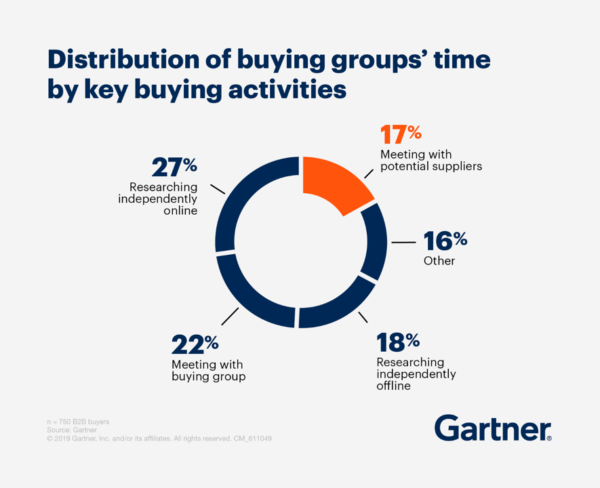
What Is Intent Data?

Your sale does not start with the first conversation between your sales team and the customer. It began when your customer recognized a problem or opportunity for their business. But they’re not ready to talk to you–there’s much more they need to do.
According to FocusVision, the average B2B customer journey involves the buying committee consuming an average of 13 pieces of content, takes an average of two to six weeks, and involves 3 to 4 decision-makers.
Not all this time is spent talking to sales about solutions. That’s the smallest chunk of time in the B2B buying journey with only 17% of a buying group’s time dedicated to meeting with potential providers. Look at the graphic below from Gartner: most of the time spent by a B2B buying committee is away from solution providers. Within this time, they are using content and research to inform their decision to meet with a provider, so marketers need to be sure that buyers have the content they need to move forward in the buyer’s journey.

Instead of waiting for that first sales conversation, wouldn’t it be great to give this buying group the exact content they need to solve their problem in their research phases AND lead them to your solution? And wouldn’t it be great to know more about your buyers so you can personalize and activate a great customer experience from start to finish?
You can when you use buyer intent data.
Intent Data Explained
Buyer intent data is a collection of signals that reveal when a prospective customer is looking for or interested in learning about a solution. These signals are combined to provide marketing and sales teams with intelligence on the organizations that may be interested in additional information about a solution as they perform in-market research.
For example, if an account is consuming content on “HR software”, the act of downloading the content asset or watching the virtual event is an early indicator that this organization may want to learn more about HR software. As a result, savvy marketers can engage this account with relevant marketing content and advertising. As this prospect moves from research to inquiry about a specific solution, the sales team can understand the key points and messaging they need to close the deal.
Intent data is a valuable tool to support your ABM strategy, and B2B marketers are taking notice. In fact, a 2020 Forrester survey finds that 77% of B2B marketers are using intent data in their ABM programs, with 11% making plans to implement it in their future ABM campaigns.
First party vs. Third-party Intent Data
There are two types of buyer intent data, and both are important to the buyer’s journey.
First-party intent data: This data that your organization collects through your CRM, marketing automation platform, forms, questionnaires, registration information for events, and website visitation metrics about users.
First-party data is typically bolstered with personally identifiable information (PII), like an email address or a user’s name. This type of data is crucial to your sales team when they start to reach out to prospective buyers and can help you segment accounts by type: net-new logos, expanding customers, cross- and up-sell opportunities.
Third-party intent data: This data is collected from an outside source, I.e., not from your organization. It is the activity tracking of individuals on platforms that are not on your website or through your server.
It allows you to gain insight into intent on other sites. It gives you a more comprehensive picture of a prospect’s online interests and the ability to highlight intent on specific topics and places important to your campaign’s focus.
Why Not Both? Using Both Buyer Intent Data Types
Marketers should be paying attention to first-party intent data, good marketers utilize third-party intent data, but great marketers use both in ABM.
When you use both types of intent data, you can get full visibility into your current and prospective customers. You’ll learn who to target, what content and nurturing strategy individuals need to progress through the buying stages when in the buyer’s journey messaging should be delivered to them, where they need to find this information, and why they are engaging with your brand.
Intent data can benefit marketers in other ways:
- Stronger sales and marketing alignment: Intent data helps optimize engagement tactics and messaging for both marketing and sales. And when sales and marketing are more aligned on how to talk to their prospects, marketing can deliver more qualified leads to sales.
- Awaken sleeping buyers: We find that 70% of buyers will be hyperactive for around five days during their research and consideration process, and then go quiet before they have even reached out to a salesperson. So how do you reach the remaining 30%–those leads who are both in-market and still active? Intent data helps marketers know when a prospect is active and ready to be engaged.
- Shorten sales cycles: Have you ever wandered through a store, not sure what you’re looking for? Sometimes that’s how B2B buyers feel, especially in the early stages of the buyer’s journey. When you use intent data in ABM, you can create a personalized and targeted experience for a buyer that will lead them to where they need to be—in your sales pipeline—faster.
- Get rid of random acts of marketing: According to Karen Hayward, author of Stop Random Acts of Marketing: Deliberate & Practical Growth Strategies for Mid-Market CEOs, random acts of marketing are tactics that get deployed without rhyme or reason and are not tied to strategy. This helps no one, and marketers can see depleted budgets and lower ROI numbers when they commit random acts of marketing. Intent data takes the guesswork out of targeting buyers and gets rid of random acts of marketing. By understanding your buyers and measuring engagement with your brand, your content strategy and messaging have a purpose, and you’re not delivering messages that have little to no chance of impact. This means less wasted marketing budgets and higher ROIs.
- Transform account personas to true prospects: A good marketer has ideas about “who to target” by building account personas, but a great marketer is able to narrow down this idea to “who should we target and how.” Personas are only your best guess to target—laying buyer intent data on account personas answers that “who should we target and how” question. Once marketers know who is a true prospect, they can target accounts more efficiently.
How Buyer Intent Data Is Collected
You already know that first-party intent data is collected through means by your organization, with website tracking, visitor analytics, form fills, and content downloads. This data is also considered “directed” intent signals because they are unique to you and your organization and can’t be acquired by another company. This type of intent data can be highly predictive of purchase intent.
Third-party intent data originates from platforms that track online research activity and behavioral signals from partners like media publishers, B2B websites, and other sources. By using IP-address tracking, company mapping, and third-party cookies, intent data providers can monitor keyword searches and topics that relate to an industry or solution. Intent data providers create baselines for content consumption and engagement for each topic or company, and report on spikes that indicate the likelihood that an account researching this topic is in the market for a solution.
Use Cases for Buyer Intent Data
Now that you understand what intent data is, the types of intent data and the benefits intent data has for B2B marketing, let’s examine the use cases of intent data.
Content Marketing and Demand Generation
Content marketing is a typical pain point for B2B marketers—it is expensive and complex in many ways. Media buying and content creation is an effective way to place your brand in front of prospective buyers and educate them on your solution, but if you’re not delivering the right content built for your buyers’ interests when and where they need it to choose your organization, you will not see much of a return on your content marketing.
Buyer intent data has many applications in content marketing. It can help you identify which buyers you need to target with relevant content, reveal what your buyers are thinking about and what keywords/topics you should cover with your content, and how you can personalize your content nurturing strategy. When your content marketing is suited to the buyer’s needs and answers their questions before they ask you directly they turn into more qualified leads, you can arm your sales rep with stronger leads that convert to more wins and revenue.
Sales and Sales Enablement
Hubspot finds that 40% of sales reps say that prospecting accounts are the most challenging part of the sales process. Since the average B2B buyer is 67% through the buying journey before they engage with your sales team, your sales rep is counting on your B2B marketing to identify, prioritize, and engage with prospective buyers accurately and efficiently so they can lead them through the closed-deal finish line. Buyer intent data can support your sales team from the beginning of the buying cycle all the way down to the close of a deal or post-sales account expansion/cross- and up-sell efforts.
Customer Success and Retention
Unless you have the secret to keeping customers forever, organizations should always be focusing on customer success and retention. Unlike customer support which is a reactive function, customer success is proactive and ongoing to keep customers happy. The greatest threat is customer churn, which is always possible because there are many other B2B solutions that can solve a problem.
Preventing churn is all about understanding your customers and looking for warning signs that they may be looking somewhere else. While you can proactively check in with customers, they will not always tell you when they research other solutions, but intent data can be used to track that behavior that indicates customer churn or if they are in-market for another solution.
Furthermore, using intent data with your customer success database can help you stay in front of those accounts in-market, and help you know if there’s a problem with your relationship. Based on the content or topics that they’re researching you can examine questions like, “Is there a product feature they want that we don’t have?”, “Are they looking for a lower costing solution?”. By using intent data, you can know the problem first and provide content to address it before you lose the customer.
Now What?
Buyer intent data can give you a boost to knowing who your prospective buyers are before they even reach out to your sales team. Since the B2B buying journey is typically a long process, you can receive tons of revealing information about your prospective buyers by collecting intent data as they move through the buyer’s journey. Simply put, investment in intent data pays off in stronger overall marketing and sales performance by knowing your buyer before they make that first sales call.
Are you ready to identify, prioritize and engage with the right buyers? With ML Insights, marketers can uncover the accounts with the highest propensity to purchase. Request a demo to learn more!

